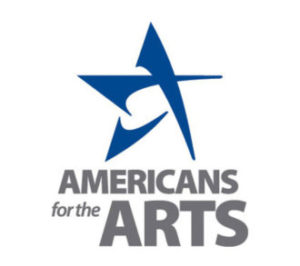This arts organization used FiscalNote’s VoterVoice in their grassroots advocacy & communication strategy in a landmark win to save federal funding
Americans for the Arts is a nonprofit whose members are local arts agencies and individuals focused on advancing the arts in the United States.
is a nonprofit whose members are local arts agencies and individuals focused on advancing the arts in the United States.
They, along with their affiliated organization, the Americans for the Arts Action Fund, use VoterVoice as their grassroots advocacy system.
The Issue
In March 2017 President Trump in his first federal budget plan proposed eliminating the National Endowment for the Arts (NEA), and the National Endowment for the Humanities (NEH).
The combined annual budgets of both endowments – about $300 million –had been deeply valued financial lifelines and highly coveted honors for arts institutions, musicians, writers and scholars for decades.
To persuade lawmakers to keep the endowments, and to capture the public’s attention, Americans for the Arts knew the clock was ticking.
They needed to bring a message to federal, state, and local lawmakers on the positive impact the arts was having on their constituents, and communities, and do it in a bipartisan approach.
A Strategic, Nationwide Grassroots & Communications Plan
To help make the case for the endowments funding, Americans for the Arts methodically put together a comprehensive 14-month campaign with several key components.
Crucial pillars of the strategy included a huge grassroots and communication plan to raise awareness, increase activism, and keep lawmakers accountable for the effect that losing the endowments would have on the arts.
With their plan in place, Americans for the Arts and the Arts Action Fund, leveraged more than 365,000 grassroots activists around the U.S. to keep constant pressure on Capitol Hill
Every time there was federal funding news, they sent out action alert emails through VoterVoice that allowed their advocates to immediately message Congress and urge them to retain NEA and NEH funding.
Ready to see for yourself?
Learn how VoterVoice helps you promote action to affect bills and regulations, as well as assess your impact and drive results.
Scaled Email Campaign
The sheer scale and reach of the advocacy campaign was unprecedented for the arts organization, with an all-time high for their VoterVoice e-advocacy of 240,000 email messages reaching every congressional office.
Aided by those digital efforts, they got 40 Senators and 154 House representatives, including a record 11 Republicans, signing “Dear Colleague” letters asking for support for level or increased funding for the NEA and NEH.
Hill Day Extraordinaire
In March 2017, the organization took to Capitol Hill with their Arts Advocacy Day. Fueled with the knowledge defunding the endowments would have, 712 grassroots arts advocates, representing every state, arrived in D.C. for over 400 face-to-face meetings with Congressional leaders and staff.
Despite its success, Americans for the Arts didn’t leave their advocacy day as a one and done event. They continued to mount fly-ins and delegations to bring arts leaders from around the country to D.C. throughout the campaign.
One of their fly-ins featured arts leaders from the specific home districts of seven key Republican appropriators, along with recording artist Ben Folds. In partnership with the National Humanities Alliance they created a buzz and produced two days of meetings on Capitol Hill with Hamilton creator Lin-Manuel Miranda.
To keep up the pressure, the Arts Action Fund also put together a 91,000-strong national petition to save the agencies, and presented it to President Trump.
Advocacy Training
Americans for the Arts knew they had to get their grasstops on the ground to carry the message to lawmakers in their home states on how constituent voters would be impacted by the lack of funding. To do that, they trained and supported over 3,000 of their local arts agency members and 7,000 of their staffs.
Multi-pronged Communications Campaign
To scale up and drive awareness of the advocacy campaign, Americans for the Arts launched multiple targeted communications tactics focusing on galvanizing the general public’s support, while reaching key decision makers and their staffs.
They placed full-page ads in national legislator focused publications, including Roll Call, highlighting the arts national economic importance and including data they knew was highly valued by specific decision makers.
Those ads reached all legislative offices, as well as an additional 600,000 stakeholders.
To reach the appropriate lawmakers responsible for writing in the funding, they put customized full-page color ads in local newspapers of the Republican Senate leaders, Appropriators, and House Interior Appropriations Committee members.
The ads detailed NEA support for the arts in their states and districts.
To drive home the point, Americans for the Arts’ local arts network submitted 100 op-eds, resulting in a massive 55 placements in separate markets reaching over four million voters in 37 states.
To help with this local media outreach, Americans for the Arts created a customizable “Letter to the Editor” feature in VoterVoice and shared op-ed examples with their local agency members.
On social media they mounted a #SAVEtheNEA campaign and a suite of shareable #SAVEtheNEA graphics and got celebrities such as Kerry Washington and Yoko Ono posting to their massive Twitter followings about the threat of defunding the federal agencies.
There were public service announcements on Facebook with celebrities such as Ben Folds and Lin Manuel Miranda, Julie Andrews, Josh Groban and Kal Pen.
They gave countless interviews and placed messaging in many media outlets including the Washington Post, Variety, Huffington Post, USA Today, Hyperallergic, Chronicle of Philanthropy, C-Span’s Washington Journal, NPR, and international venues such as the Guardian and the BBC.
Garnering Bipartisan Support
To boost their campaign Americans for the Arts worked with some unlikely political allies and voices across the aisle.
Second Lady Karen Pence, kicked off a formal event for the NEA’s Creative Forces initiative, which Americans for the Arts helps to manage, at the Vice President’s residence. She also attended several forums around the country to speak about the value of art therapy, and at the January 2018 Arts Breakfast that Americans for the Arts hosted with The U.S. Conference of Mayors about the value of bipartisan support for the arts.
For her support over many years on the Appropriations Committee and in Alaska, Republican Senator Lisa Murkowski received Americans for the Arts’ Congressional Leadership award at their Arts Advocacy Day in 2017.
Americans for the Arts worked closely with key Democrats, too, including the entire Democratic leadership. For example, Rep. Nancy Pelosi keynoted Americans for the Arts’ annual conference in 2017, speaking passionately about the value of the arts and her support for it.
The Result?
Americans for the Arts’ efforts paid off. Big time.
Congress soundly rejected the call to terminate the National Endowment for the Arts and the National Endowment for the Humanities.
Not only did the president’s proposal to eliminate the NEA and the NEH not materialize, funding actually increased at each agency by $3 million in FY 2018, and by $2 million in 2019. Currently, the FY 2020 U.S. House Interior bill calls for a $12.5 million increase for each agency as Americans for the Arts, joined by hundreds of arts advocacy organizations pushes Congress to secure $176 million – the historic high point – last seen in 1992.


